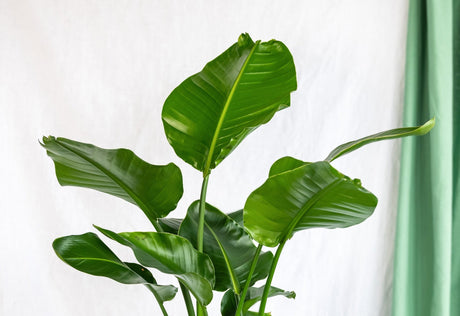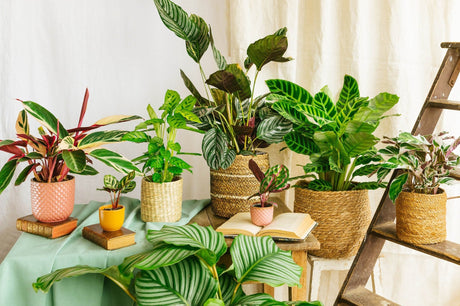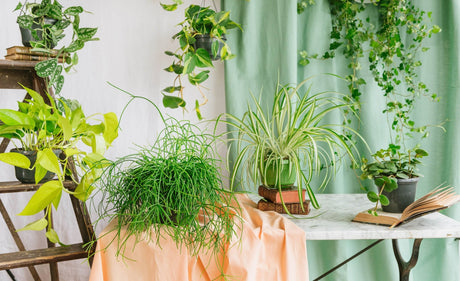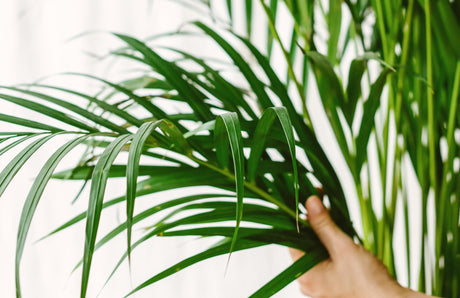Ivy (Hedera) is a popular houseplant loved for its cascading beauty and its ability to adapt to various conditions of growth. Boasting vibrant leaves and vigorous growth, Ivy is the perfect companion to bring a touch of greenery to your space interior.
Ivy leaves have a variety of shapes and textures, ranging from smooth to lobed. Some varieties feature patterns variegated, adding a visual dimension to your interior.
Ivy is a climber natural. It can be grown on trellis, shelves hanging or supports to create a green cascading effect.
1. Watering the Ivy
The frequency of watering depends on the environmental conditions. In general, water when the top top layer of the soil is dry, but avoid letting the soil become completely dry.When watering, make sure the water flows slowly through the pot. Water enough so that excess water runs out through the drainage holes in the pot.
Tip: Insert your finger into the ground to a depth about 2 to 3 cm. If the soil is dry at this depth, it is usually time to water it.
2. Watering techniques
Watering from below
Base watering involves adding water directly to the soil of the potSlender Spout Watering Can
Gently and evenly water the soil around the plant. Make sure the water flows freely through the pot's drainage holes. Avoid watering the leaves directly to reduce the risk of fungal diseases.3. The Ivy Exhibition
Exposure to light is crucial for the well-being and growth of your Ivy. Choosing the right location and adjusting the exposure to suit its needs will allow your plant to thrive.Ivy generally thrives in bright indirect light.Avoid direct sunlight, as it can scorch the delicate leaves of the Ivy.
4. When should I repot my Ivy?
Repotting ivy is an important step in ensuring the health and optimal growth of your plant.Spring is generally the time optimal for repotting your Ivy. This season marks the beginning of the season of growth active for many plants, including Ivy. Repotting at this time allows the plant to adapt more quickly to its new pot and take advantage of the vigorous growth period to develop new roots .Here are some signs to watch out for:
Visible roots
If you see roots sticking out of the pot's drainage holes or forming a dense tangle on the surface of the soil, it's time to repot. Excessive rooting may indicate that the current pot has become too small for the plant.Slowed growth
If your Ivy is growing slower than usual, has smaller leaves, or seems less vigorous despite proper care, it may be a sign that its roots are tight and need more vigor. space to grow.Depleted Soil
If you've noticed water dripping quickly through the pot when watering, this may indicate that the soil has become compacted and less efficient at retaining moisture and nutrients.Frequent watering
If your Ivy requires very frequent watering because the soil dries out quickly, this could indicate that the pot has become too small to hold enough water.Leaf losses
If your Ivy suddenly loses a lot of leaves for no apparent reason, it could be due to stress caused by cramped roots or drainage issues.5. What fertilizer should I use for my Ivy?
For indoor ivy, you can opt for a balanced fertilizer formulated for indoor green plants. Here are some tips for a better use:Dosage and frequency
In general, apply fertilizer every 4-6 weeks during Ivy's active growth period (spring and summer). Decrease frequency during fall and winter months when growth is slower.Carefully follow the dosage instructions on the fertilizer package. Using more than recommended can lead to excessive buildup of salts in the soil, which can harm the plant.Water before fertilizing
Before applying fertilizer, water your Ivy with water. This avoids an excessive concentration of salts and nutrients around the roots.Avoid the leaves
Avoid putting fertilizer directly on the leaves of the Ivy, as this can cause burning or spotting. The fertilizer must be applied to the soil so that the roots can absorb it.6. How do I multiply my Ivy?
To multiply your Ivy, you can use the method of cuttings in taking a healthy stem. Cut a section of stem approximately 5 to 10cm long, just below a node. Remove the bottom leaves to expose the nodes.Place the cutting in a substrate light and well-draining, making sure ensuring that at least one node is buried.Keep the substrate slightly wet and place the cutting in a place
7. Ivy Diseases
Ivy is generally a hardy plant, but like all plants, it can be prone to certain diseases. Here are some diseases common that could affect your Ivy:
Oidium
Powdery mildew is a fungal disease that manifests as a white or gray powdery coating on the leaves.
Root rot
Root rot is caused by excess moisture in the soil
Anthracnose
Anthracnose is another fungal disease that causes brown, necrotic spots on leaves.
CMealybugs and Aphids
Mealybugs and aphids are insect pests that can attack Ivy. They feed on plant sap.
Leaf spots
Leaf spots can be caused by different bacteria or fungi and show up as spots of different sizes and colors on the leaves.
8. Delivery and reception of your plant
- Your plant is dry ? Bathe her for ten minutes.
- Your plant is wet ? Let the potting soil dry.
- Should I repot my






